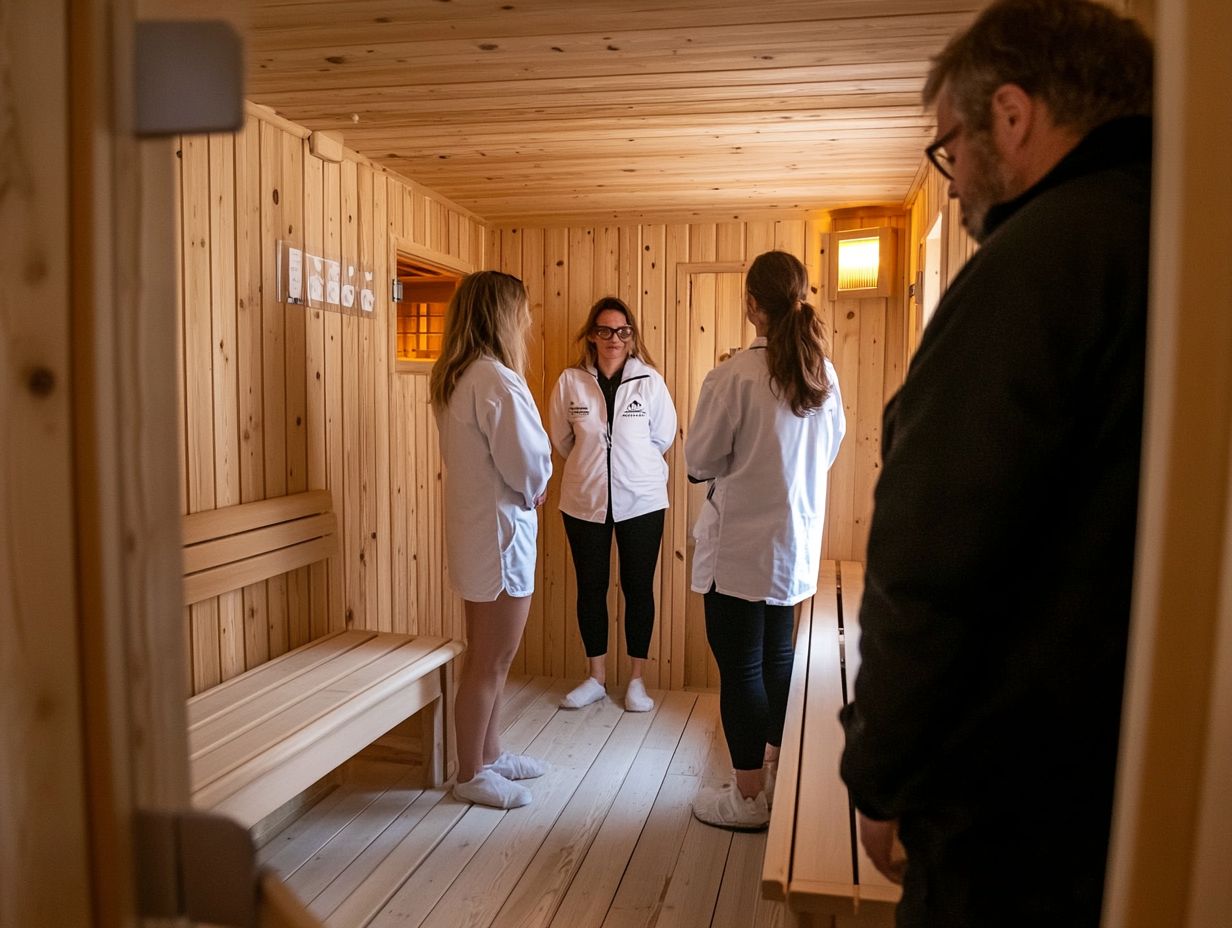Sauna Safety: The Importance of Training Staff
Saunas provide many physical and mental health benefits, ranging from deep relaxation to enhanced circulation.
However, these advantages come with certain risks that could compromise safety. It s essential to recognize the importance of having trained staff to manage these environments effectively.
Let s explore the benefits of sauna use, address common safety concerns, and highlight the critical role of well-trained personnel in accident prevention.
Immerse yourself in this discussion to discover how to elevate your sauna experience while ensuring the safety of everyone involved.
Contents
- Key Takeaways:
- The Benefits of Sauna Use
- Understanding Sauna Risks
- The Role of Trained Staff in Sauna Safety
- Common Sauna Accidents and How to Prevent Them
- Ensuring Customer Safety in the Sauna
- Frequently Asked Questions
- What is the importance of training staff in sauna safety?
- What are some potential risks in a sauna?
- What topics should be covered in sauna safety training for staff?
- How often should staff receive training on sauna safety?
- What should a staff member do if they notice a safety issue in the sauna?
- Are there any regulations or guidelines for sauna safety training for staff?
Key Takeaways:

- Properly trained sauna staff can prevent potential dangers and accidents, ensuring customer safety.
- Sauna staff should be certified and trained in identifying and addressing hazards for a safe and enjoyable experience.
- The presence of trained staff is crucial for a safe and pleasant sauna experience.
The Benefits of Sauna Use
Using a sauna, whether at a fitness center like the YMCA or in your own private space, offers an array of health benefits that can enhance your physical and mental well-being.
Regular sauna sessions can significantly improve your cardiovascular health, support workplace wellness, and relieve issues like muscle soreness and high blood pressure.
Saunas also help detoxify your body by flushing out toxins and replenishing electrolytes, which are minerals that help balance fluids in your body. They are essential for anyone seeking relaxation and rejuvenation.
Physical and Mental Health Benefits
Using a sauna offers a remarkable blend of physical and mental health benefits through the release of endorphins that lift your mood and reduce stress levels.
This soothing practice aids in muscle recovery and boosts circulation. It can also support those managing conditions like arthritis, calming inflamed joints and enhancing flexibility, making everyday movements easier.
From a mental health perspective, regular sauna sessions can cultivate a profound sense of tranquility and community, especially in group settings, providing relief from anxiety and depression.
Overall, these effects position sauna use as a vital tool for nurturing both your body and mind, promoting wellness in a holistic way.
Understanding Sauna Risks
While saunas provide many health benefits, it’s crucial to recognize the potential dangers that come with their use. Risks such as dehydration, overheating, and complications from pre-existing conditions like high blood pressure can arise if you don t follow safety guidelines.
Consulting with a medical professional before starting sauna sessions can significantly reduce these risks and help ensure a safe and enjoyable experience.
Risks and Safety Concerns

The risks associated with sauna use primarily focus on dehydration and managing elevated body temperature, especially for those with high blood pressure.
If you have cardiovascular issues, are pregnant, or are elderly, these risks can increase, as your body may find it harder to adapt to extreme heat. Recognizing signs of overexertion, like dizziness or excessive sweating, is crucial as they can indicate heat-related illnesses.
Staying properly hydrated before and after your sauna session is vital; the fluids lost through sweat can lead to serious issues if not replenished. To enjoy a safe sauna experience, monitor your time in the sauna and consult a healthcare provider if you have any pre-existing conditions that might heighten these risks.
The Role of Trained Staff in Sauna Safety
The presence of trained staff in a sauna facility is essential for ensuring your safety and well-being. Having properly trained personnel allows them to enforce safety rules, educate you on best practices, and respond effectively in emergencies.
By adhering to Occupational Safety and Health Administration (OSHA) guidelines and obtaining relevant certifications, these professionals foster an environment that maximizes the health benefits of sauna use while minimizing potential risks. This ensures a safer and more enjoyable experience for all users.
Importance of Proper Training and Certification
Proper training and certification of sauna staff significantly enhance user safety and the overall success of fitness centers.
When staff members are well-trained, they not only understand how to operate sauna equipment but also know the essential safety protocols that prevent accidents and ensure an enjoyable experience for patrons. Understanding the importance of sauna safety training is crucial. Their responsibilities include keeping the right temperature, maintaining hygienic conditions, and identifying potential health risks for users.
Certified staff are better positioned to educate sauna users on best practices, such as proper hydration and optimal duration of use. This enables your fitness center to uphold rigorous safety standards and cultivate an environment where customer well-being is the priority.
Common Sauna Accidents and How to Prevent Them
Common sauna accidents can vary from minor mishaps to serious health issues, making it essential for you to implement effective prevention strategies. By understanding the safety tips and rules around sauna use, you can significantly decrease the likelihood of these accidents.
Prioritizing adequate hydration, being aware of your personal limits, and ensuring proper supervision are vital components that will help you enjoy the sauna experience safely.
Identifying and Addressing Hazards

Identifying and addressing hazards within a sauna environment is crucial for ensuring your safety and comfort.
Being aware of potential risks like overheating, slips, and electrical malfunctions can significantly enhance your overall sauna experience. It’s wise to familiarize yourself with safety guidelines, such as limiting your session duration to prevent dehydration and being mindful of sudden temperature changes.
Maintaining a clean sauna is equally important to minimize slip hazards. Ensure that benches are dry and free from obstacles to enhance your relaxation. Know the sauna’s maximum capacity and understand your own physical limitations to help prevent accidents. Everyone should embrace these strategies for a safer, more enjoyable experience.
Ensuring Customer Safety in the Sauna
Ensuring customer safety in the sauna requires a multifaceted approach that hinges on well-trained staff, effective communication, and the implementation of best practices.
By cultivating a comprehensive safety culture within the facility, you create an environment where users can truly relax and feel secure while reaping the myriad health benefits that saunas offer.
Best Practices for Sauna Staff
Best practices for sauna staff are crucial in creating an environment that prioritizes your safety while enhancing your overall experience.
To establish a secure atmosphere, staff members undergo rigorous training that covers first aid, emergency protocols, and essential operational guidelines. This training equips them to handle a variety of situations effectively, whether it s managing overcrowding or identifying guests who may be experiencing heat-related distress.
Regular refresher courses help staff stay sharp and informed about the latest safety regulations and equipment. By cultivating a knowledgeable and attentive team, the sauna not only adheres to regulatory standards but also creates a welcoming atmosphere that encourages you to fully embrace your wellness journey.
Frequently Asked Questions
What should I do if I feel dizzy in the sauna?
If you feel dizzy, leave the sauna immediately, drink water, and rest.
How long should I stay in the sauna?
It s generally recommended to stay for no more than 15-20 minutes at a time, depending on your comfort level.
Join us for a safe and relaxing experience in our sauna!
What is the importance of training staff in sauna safety?

Training staff in sauna safety is essential for the safety and comfort of users. It helps prevent accidents and injuries while maintaining cleanliness.
What are some potential risks in a sauna?
Sauna users face risks like dehydration and burns. High heat and humidity can also cause fainting or slips.
What topics should be covered in sauna safety training for staff?
Training should cover topics including sauna etiquette, emergency procedures, equipment use, and maintaining cleanliness.
How often should staff receive training on sauna safety?
Staff should definitely receive training at least once a year! This keeps them updated on new procedures and ready to handle safety concerns.
What should a staff member do if they notice a safety issue in the sauna?
Staff should act immediately upon noticing any safety issue. This might mean adjusting the temperature, giving water, or calling for help.
Are there any regulations or guidelines for sauna safety training for staff?
Yes, organizations like the International Health, Racquet & Sportsclub Association set guidelines. Facilities must follow these to keep sauna users safe.






